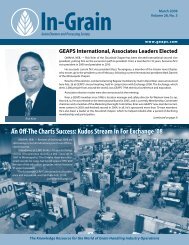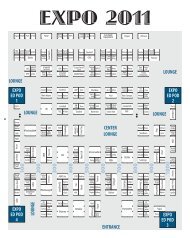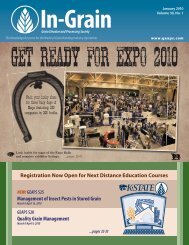In-Grain - GEAPS
In-Grain - GEAPS
In-Grain - GEAPS
You also want an ePaper? Increase the reach of your titles
YUMPU automatically turns print PDFs into web optimized ePapers that Google loves.
<strong>GEAPS</strong>, NGFA Meet With OSHA on Sweep Auger PolicyOn Aug. 11, representatives from <strong>GEAPS</strong>and the National <strong>Grain</strong> and Feed Associationmet with Occupational Safety and HealthAdministration officials to discuss the methodsand procedures used for the operation ofsweep augers inside grain bins.The meeting was based upon OSHA’srequest to learn more about the process ofremoving grain from a bin as it developed aresponse to a letter from an insurance companyrepresentative asking the agency toexplain its “policies and procedures” for operatinga sweep auger.<strong>In</strong> January 2009, OSHA posted on its<strong>In</strong>ternet site a letter of interpretation drafted inresponse to questions posed by the insurancerepresentative, who had asked if a sweep augercould be operated without the sump beingprotected by some type of machine guarding,like grating.Other than a provision in the OSHA grainhandling safety standard (1910.272) thataddresses whether an employee may enter abin when machines are operating, OSHA doesnot have a formal policy addressing the operationof sweep augers. However, a best practicesdocument referenced by the insurance companyrepresentative stated that an employeeshould work within six feet of the auger insidethe bin. The insurance company representativefailed to note in his correspondence with OSHAthat the best practices document had beendeveloped in 1996 by a state grain and feedassociation in concert with an OSHA regionaloffice. <strong>In</strong> response to the insurance representative’sletter, OSHA stated it would not considermaintaining a distance of six feet from partiallyguarded or unguarded energized equipmentwithin a storage bin to be “other equally effectivemeans or methods” as set forth in the grainhandling standard [1910.272(g)(1)(ii)].The NGFA, which became aware of theissue when the OSHA response letter wasposted on the agency’s Web site, subsequentlycontacted OSHA to obtain clarification. At thattime, OSHA told the NGFA that it had receiveda second, follow-up letter from the insurancerepresentative asking the agency: 1) if asweep auger can be operated in a bin with anemployee present; and 2) if not, what methodor procedure OSHA would find acceptable forremoving grain from flat-bottom grain bins.OSHA agreed to meet with the NGFA and<strong>GEAPS</strong> to discuss how sweep augers operate,how they are used within the grain-handlingindustry and how the initial best practicesdocument was developed prior to issuing aresponse to the insurance representative’ssecond letter. Representatives of three OSHAentities were involved in the meeting – theDirectorate of Standards and Guidance, theDirectorate of Enforcement Programs and theSolicitor’s Office. During the meeting, severalmeans of addressing employee safety whileoperating a sweep auger were discussed,including: 1) job safety analysis; 2) lockout/tagout of equipment; 3) confined space entrypermits; 4) machine guarding; and 5) providingspace between auger and employee, whilethe auger is in use. The NGFA and <strong>GEAPS</strong> alsoemphasized that in the preamble of the grainhandling standard, OSHA based the finallanguage for Section 1910.272(g)(1)(ii) on commentsthat more flexibility is needed to protectemployees from equipment when workinginside bins, silos or tanks.OSHA stated that the information providedby the NGFA and <strong>GEAPS</strong> had been veryuseful, and would be considered as the agencydetermines how to respond to the insurancerepresentative’s second letter.has stabilized its ability to provide efficientcommodity logistics for its customers.Elevator M, located in Superior’s East End,is primarily a rail shipment facility. The elevator,on the site of Cargill’s seminal port elevator,has a capacity of 2.25 million bushels.Superior’s Daisy Mill is the oldest survivingremnant of a once thriving flour industry in theharbor. The main workhouse was constructedin 1893. The elevator, including its large storageannex, has a storage capacity of 1.5 millionbushels, and is currently used for the storageof oats. Hansen-Mueller had been leasing theproperty from ConAgra for several years priorto the purchase.W.B. Duluth StorageW.B. Duluth Storage’s Duluth elevator,formerly Cargill’s, is considered the harbor’smost modern and efficient elevator complex.The elevator’s main storage and shipping sectionopened in 1977 and was expanded the followingyear. The remains of an older complex,built in 1919, bring the total storage capacityof the complex to 12 million bushels. Whiteboxis capable of handling large unit trains and ofloading vessels at the rate of 3,000 tons perhour. Whitebox is in the process of painting itsDuluth elevator.Duluth Lake Port Storage LLC<strong>In</strong> August 2008 Ag Processing, <strong>In</strong>c., ofOmaha sold its wholly owned subsidiary AGP<strong>Grain</strong>, Ltd., to Columbia <strong>Grain</strong> of Portland. Subsequently,the elevator has been purchased byRiverland Agriculture, Ltd. (Riverland Ag) of Calgary.Riverland Ag is the Canadian subsidiaryof Minneapolis-based hedge firm of WhiteboxAdvisors. The 4 million bushel elevator is onthe site of Duluth’s first flour mill, and waslater home to the Capital Elevator Company,founded in Duluth in 1905.Gavilon <strong>Grain</strong> LLCGavilon <strong>Grain</strong>, LLC, a subsidiary of theOspraie group, operates the 8 million bushelelevator on Superior’s Connor’s Point. Theelevator was built in 1966 for the Chicago,Northwestern Railroad and operated for manyyears under a lease to Continental <strong>Grain</strong>. <strong>In</strong>recent years the elevator was owned by thePeavey Elevator division of ConAgra. <strong>In</strong> the1970s, it was a pioneer in the Port in the handlingof sunflower seeds.Recently in the Twin Ports, hedge firmshave purchased three large terminal elevators.<strong>In</strong> January 2008, the elevator assets of Cargill’sDuluth complex were purchased by WhiteboxAdvisors LLC., and the former AGP elevatorwas acquired by Riverland Ag. “It’s a huge disadvantageto not be able to trade the physicalcommodity,” stated Andrew Redleaf, the headof Whitebox, regarding his firm’s purchases ofelevators.If the AGP and Cargill sales weren’t surprising,the sale six months later of ConAgra’sConnor’s Point elevator certainly was. TheOspraie Special Opportunities Fund, an affiliateof the New York-based Ospraie Management,purchased not only the elevator, but theentire trading and marketing operation of theConAgra Trade Group.Forecasting the future of these elevatorsis a lot like predicting the weather. As infrastructureimprovement of the Seaway lagsbehind the growth of deep-water ships, Pacificand Gulf coast elevators are going to continuetheir dominance in the movement of NorthAmerican grain.It would seem that in the long term theworld’s demand for food is going to increaseand that control of the elevators in Duluth-Superior will provide opportunities to storeand ship grain through the Port. The Twin Portswill continue to play a role in that long-termstrategy.Superior native Pat Lapinski writes extensivelyon current and historic maritime subjects.www.geaps.com <strong>GEAPS</strong> <strong>In</strong>-<strong>Grain</strong> | October 2009 – 5













